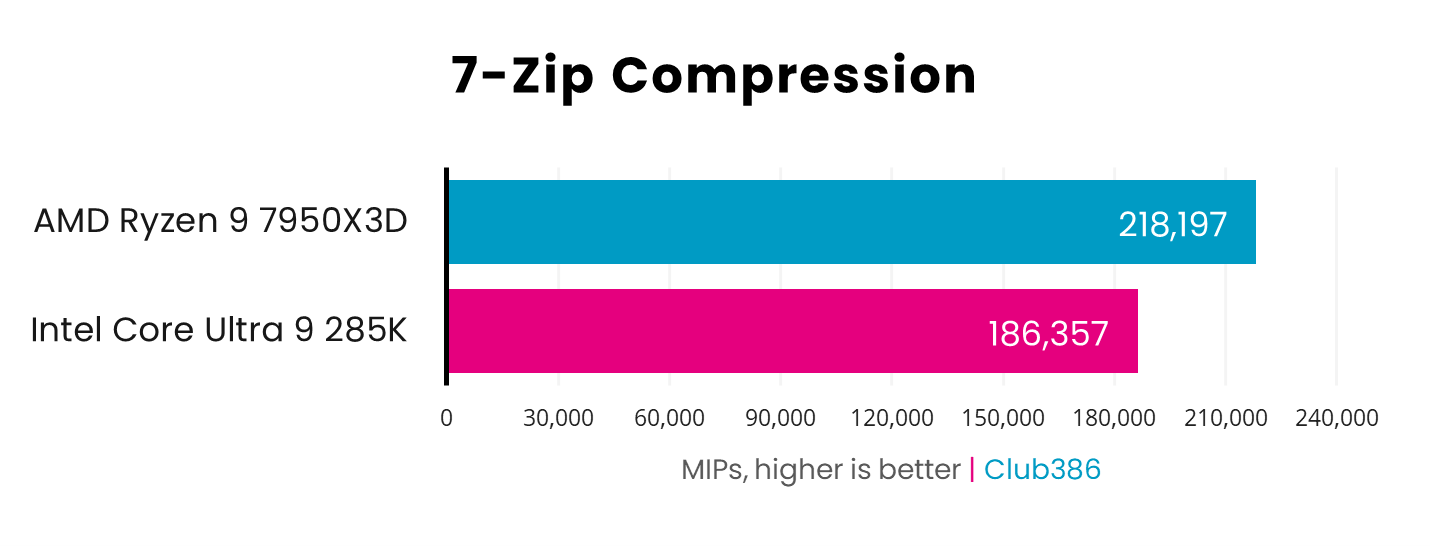Considering that efficiency is the name of the game for CPUs in 2024, it’s only fitting that we pit Intel Core Ultra 9 285K against AMD Ryzen 9 7950X3D. After all, the previous-gen Zen 4 chip is the current efficiency champ ahead of Arrow Lake’s release, despite Zen 5’s attempts to dethrone it.
Our comparison will determine which, if either, are worth the upgrade, by running each processor through its paces. We use a variety of categories, from productivity to gaming, but one look at the specs is already quite telling right off the bat.
Specs
| Intel Core Ultra 9 285K | AMD Ryzen 9 7950X3D | |
|---|---|---|
| Cores | 24 (8P+16E) | 16 |
| Threads | 24 | 32 |
| TDP (base / max) | 125W / 250W | 120W |
| L3 Cache | 36MB | 128MB |
| Base clock | 3.7GHz* | 4.2GHz |
| Boost clock | 5.7GHz* | 5.7GHz |
| Launch MSRP | $579 / £549 | $699 / £649 |
Enthusiasts might get a sense of deja vu as AMD hasn’t changed its core and thread counts since 2019. However, unlike Intel’s evolution to hybrid performance and efficient cores with hyperthreading nowhere to be seen, Team Red sticks to 16 full-fat cores and 32 threads. Six of one and half a dozen of the other.
Arrow Lake is certainly more scalable, with the opportunity of doubling its base TDP, priming fast performance in short bursts. Alternatively, Zen 4’s 3D V-Cache is more than triple Intel’s L3 offering, positioning it better for gaming. Two distinct markets, and you might need to choose which is your priority depending on the outcome of our tests.
Intel has thought long and hard about its CPU pricing, slotting Core Ultra 9 285K into the market $10 cheaper than the i9 it’s replacing. Meanwhile, AMD still struggles to find the right cost for its X3D models. Not only did 7950X3D start life with a lofty premium attached, but it still costs more than its competitor a year and a half after its release, currently running $598. It’s safe to say value isn’t its strong suit.
Performance
We conducted each benchmark from scratch on a freshly updated Windows 11 24H2 system, complete with the latest BIOS and only using the recommended TDPs. This way, everything’s fair and we control all possible variables.
AMD Ryzen 9 7950X3D rests on an MSI MEG X670E Ace motherboard, while Core Ultra 9 285K uses Gigabyte Z890 Aorus Pro Ice. Otherwise, each is paired with Zotac GeForce RTX 4090, be quiet! Dark Power 13 1,000W, Arctic Liquid Freezer III 420, and 64GB (2x32GB) Kingston Fury Beast DDR5-6000 CL36 to round out the components.
Productivity
Ryzen 9 7950X3D’s extra threads come in handy for 7-Zip tests, giving AMD a 17% advantage. Comparatively, Core Ultra 9 285K’s performance with compression is middling at best.
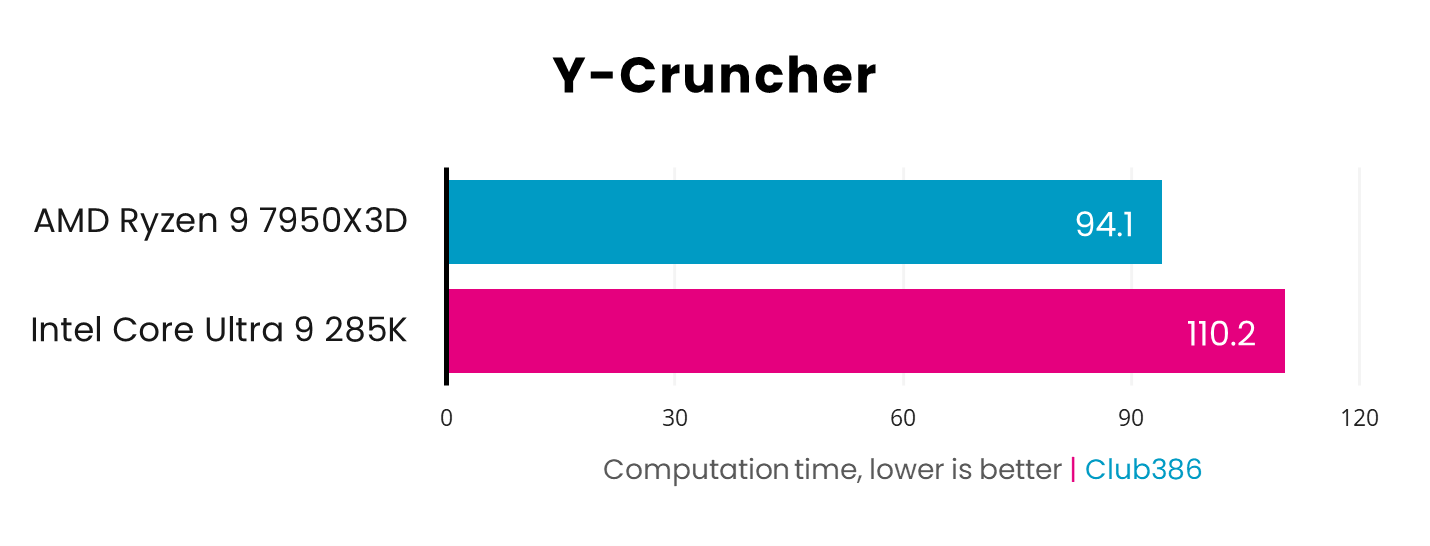
We know Arrow Lake leaps over its predecessor with some ease but meets resistance from Team Red in Y-Cruncher. Ryzen’s former flagship computes mathematical equations 15% faster, running rings around its rival.
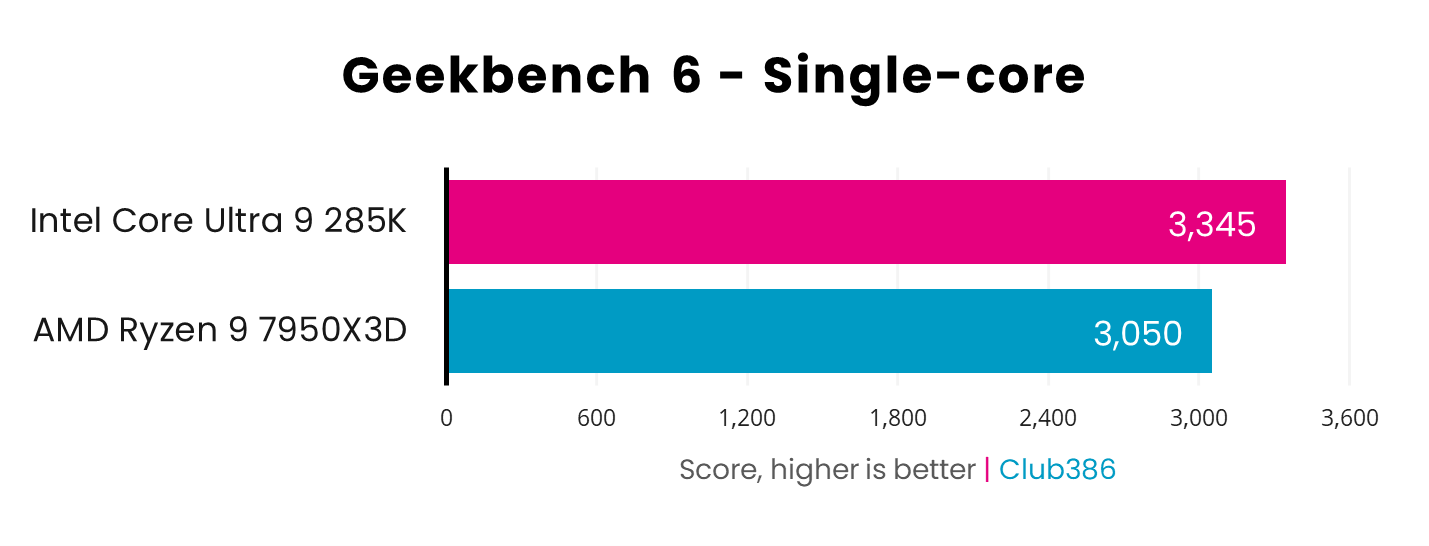
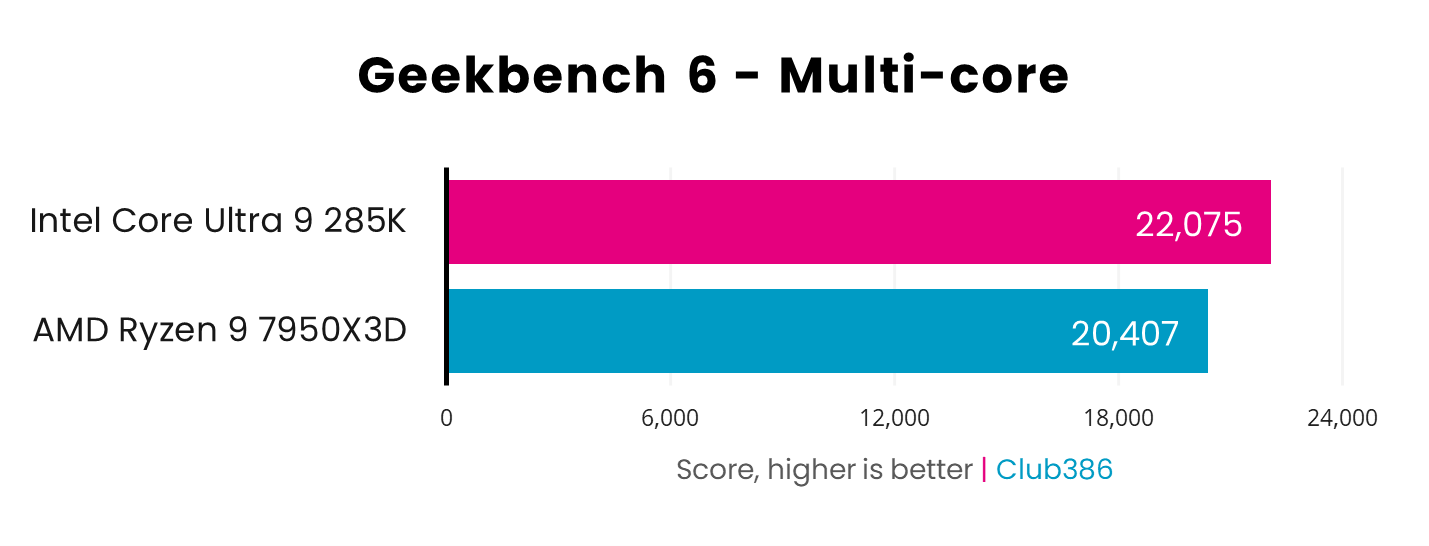
AMD buckles under the might of Core Ultra 9 285K’s eight extra efficiency cores. The boys in blue boast 10% higher scores in Geekbench 6 single-core tests and 8% more in multi-core runs.
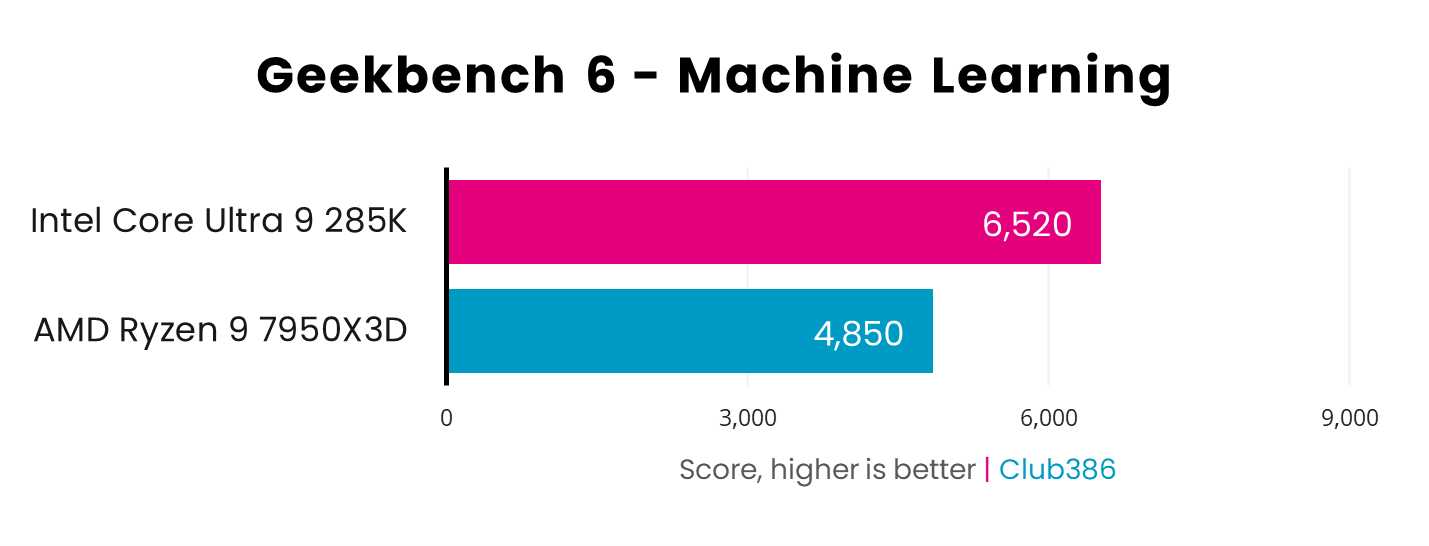
Intel better prepares its chips for AI workloads by cramming an NPU (neural processing unit) under the hood, while Zen 4 steers the course without. Fortunately for Ryzen 9 7950X3D, Geekbench 6 machine learning tests lean solely on the CPU, giving it a fighting chance. Still, Core Ultra absolutely clears by 34%, making it the de facto for float32, float16, and int8 data types.
Rendering
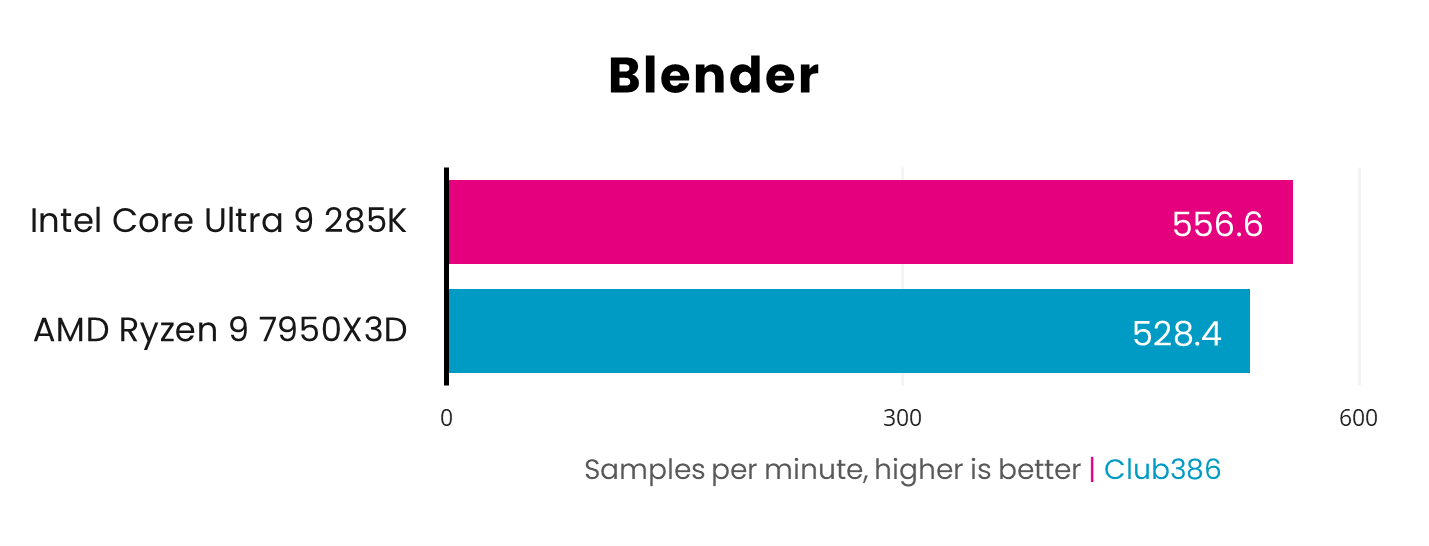
There is just a 5% difference between both CPUs running Blender rendering tests. No matter the margin of victory, it’s still an Intel win, especially considering the app is something of an AMD playground.
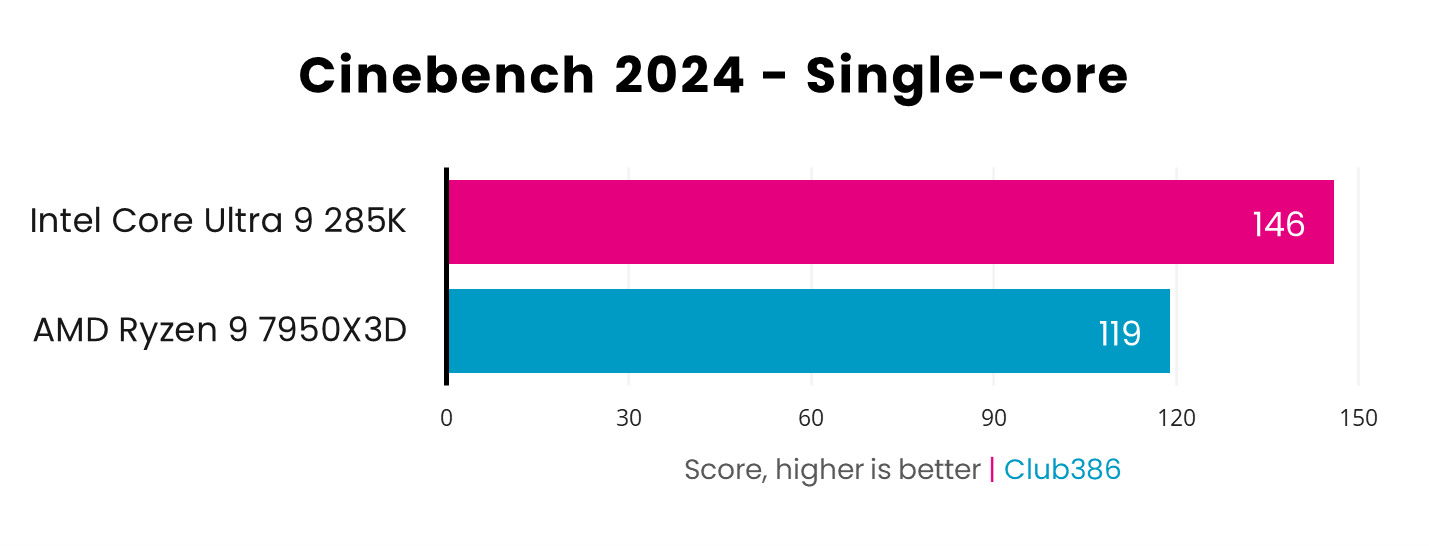
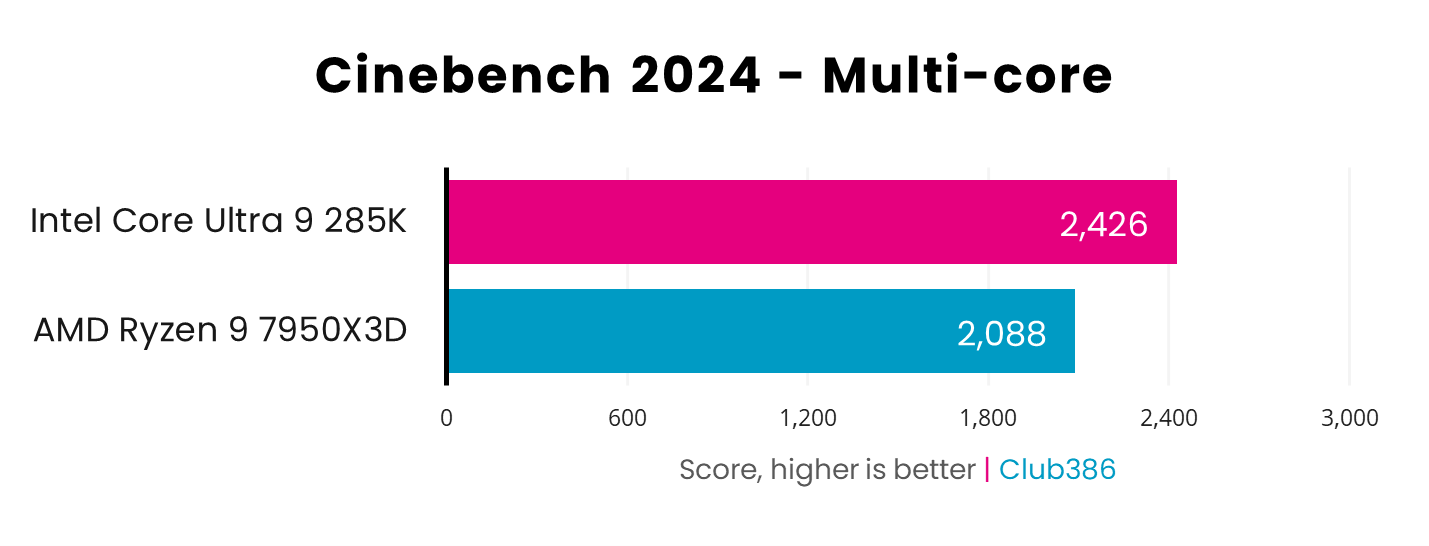
There’s no surprise that the beefier 24-core Arrow Lake chip outpaces the 16-core Zen 4 alternative in Cinebench 2024 with a decent 16% lead in multi-core tests. It’s not just about packing more, though. A 23% gap in single-core scores shows Intel has lined up all its architectural ducks.
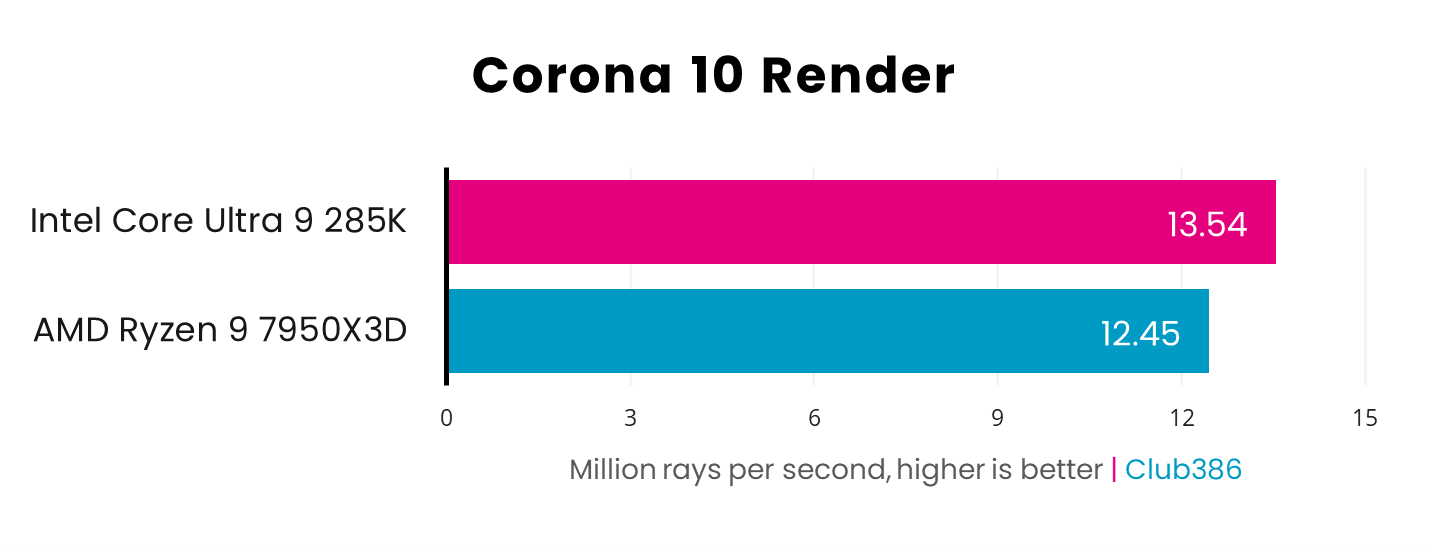
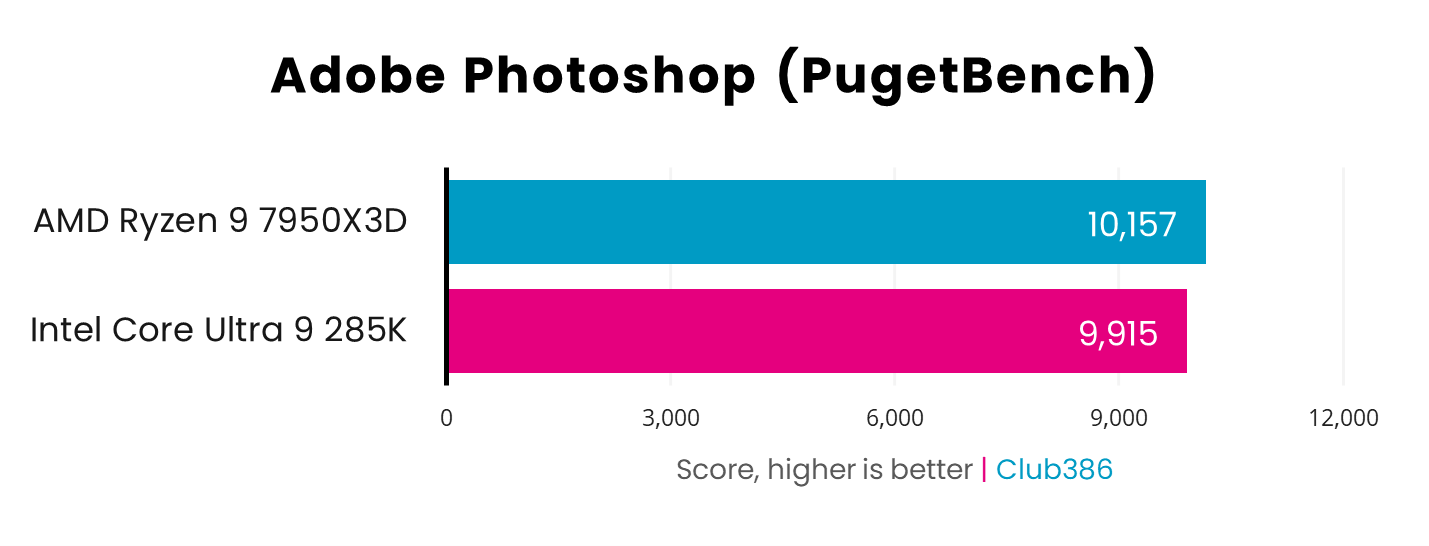
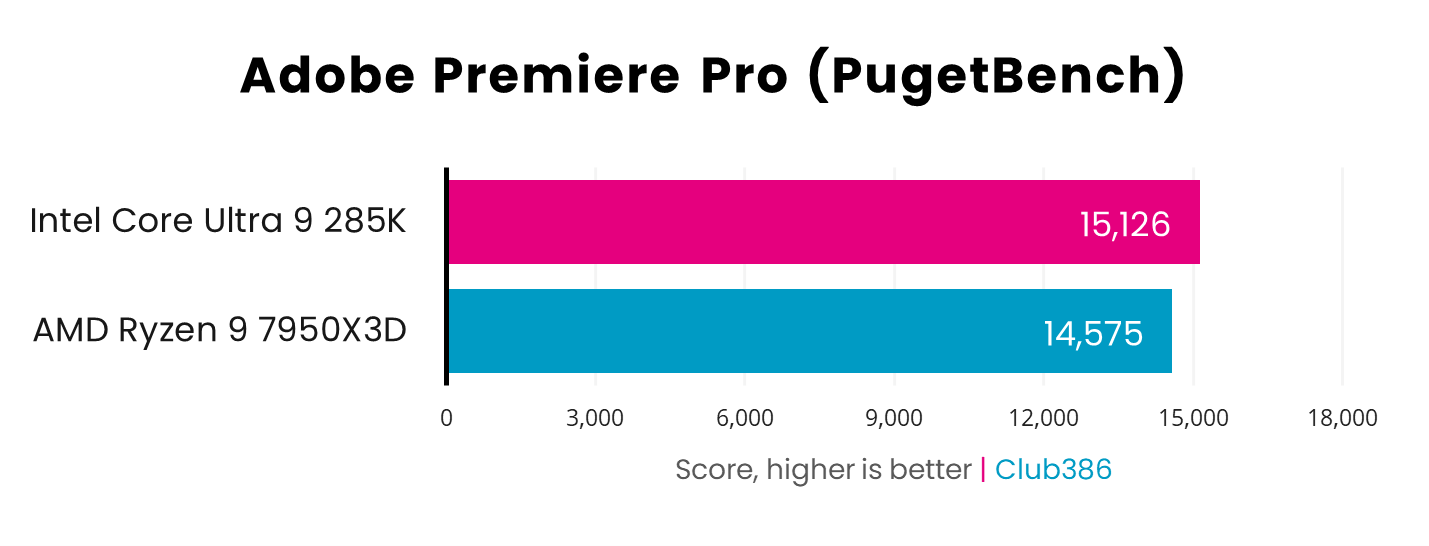
You know the saying: time is money, and Intel saves you 9% of it when it comes to Corona 10 rendering. You won’t see the same lead in photo or video workloads, as there’s just 4% in it between the chips running Adobe products.
Memory
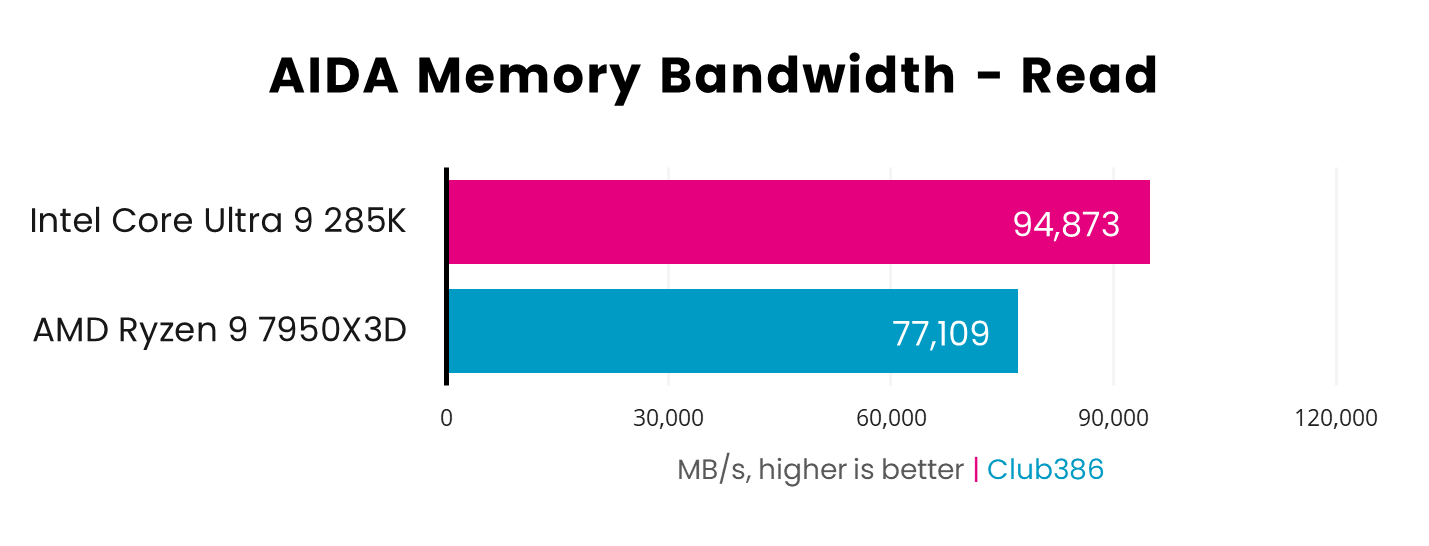
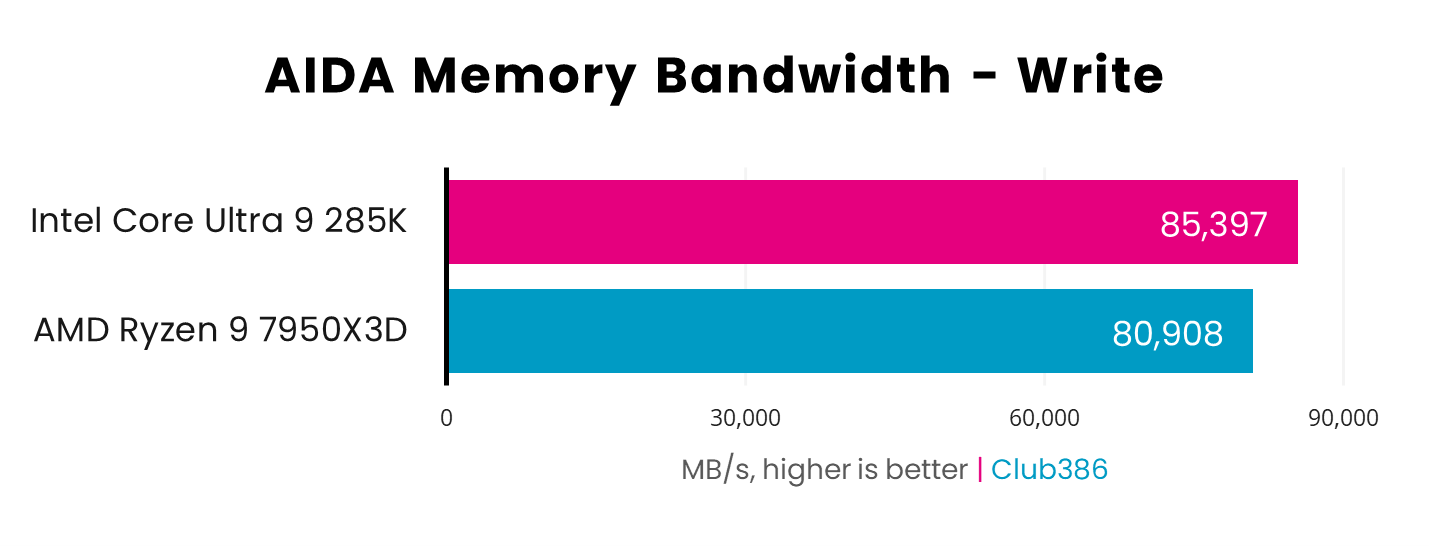
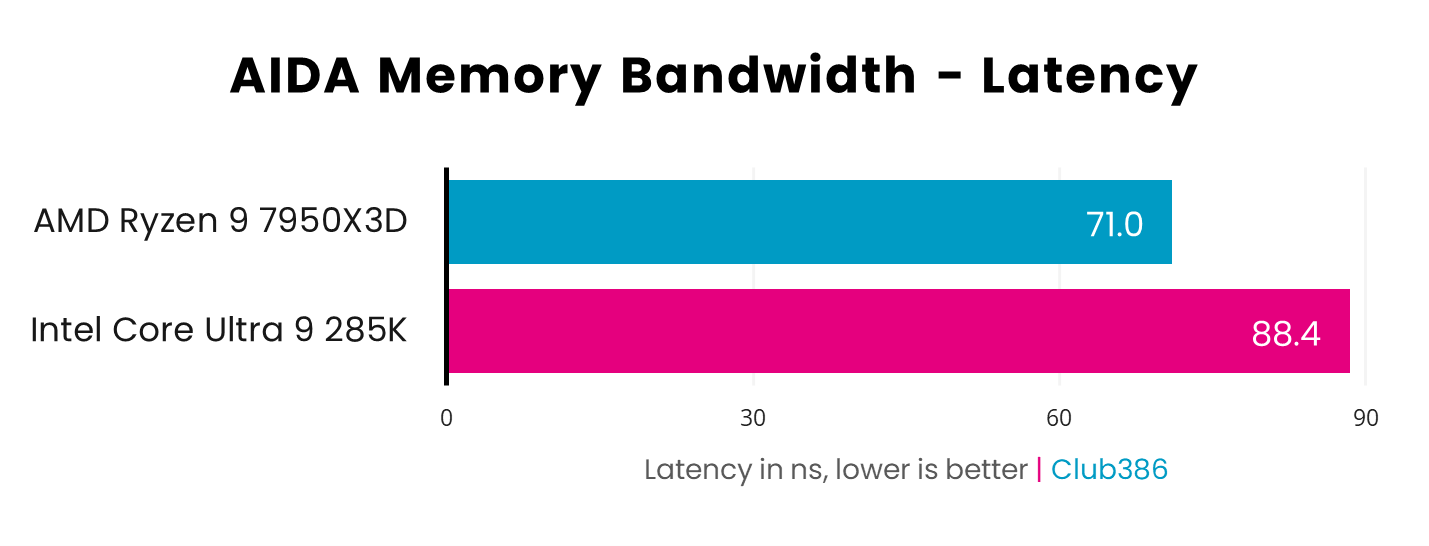
Arrow Lake is particularly good with memory read speeds. Not only is the top brass 23% better than Ryzen 9 7950X3D using the same modules, but it’s the fastest of all processors we’ve benchmarked. Write speeds are far tamer, affording Intel a 6% lead.
At this point in time, we chalk Core Ultra 9 285K’s poor latency up to a flaw in AIDA’s reporting system, as is sometimes the case with an unreleased product. This could change and is nothing to be worried about just yet.
Gaming
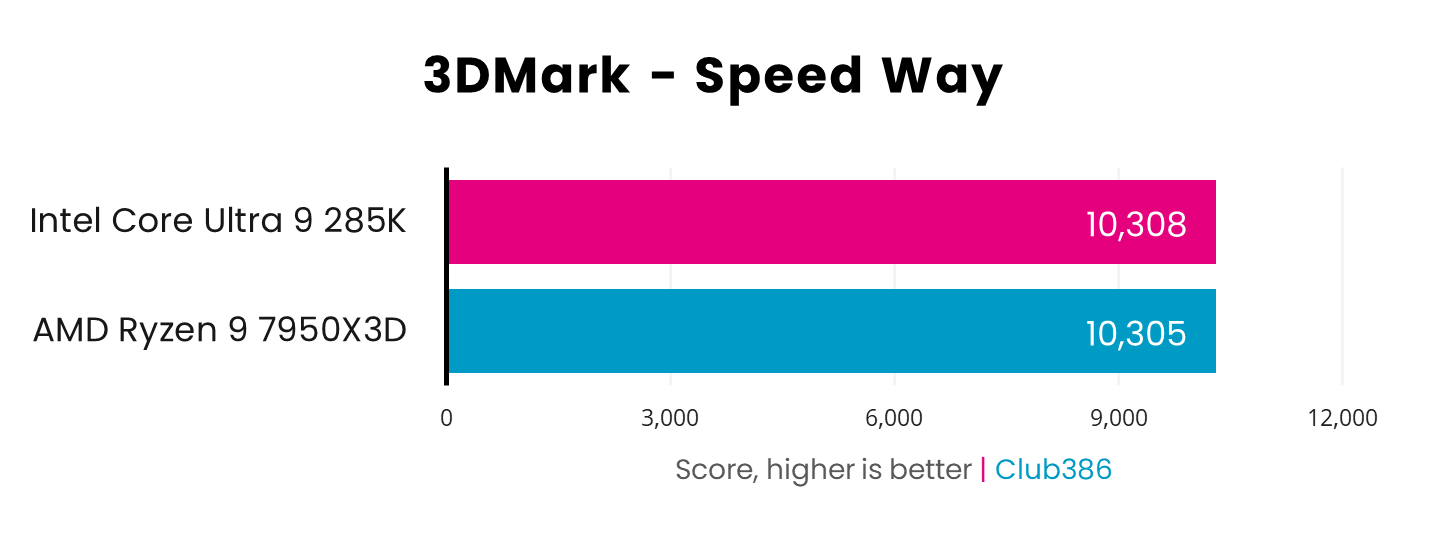
As usual, no CPU pulls ahead of the pack in 3DMark Speed Way tests. All processors we’ve run through the application alongside Nvidia GeForce RTX 4090 perform remarkably consistently to the point you won’t spot a difference.
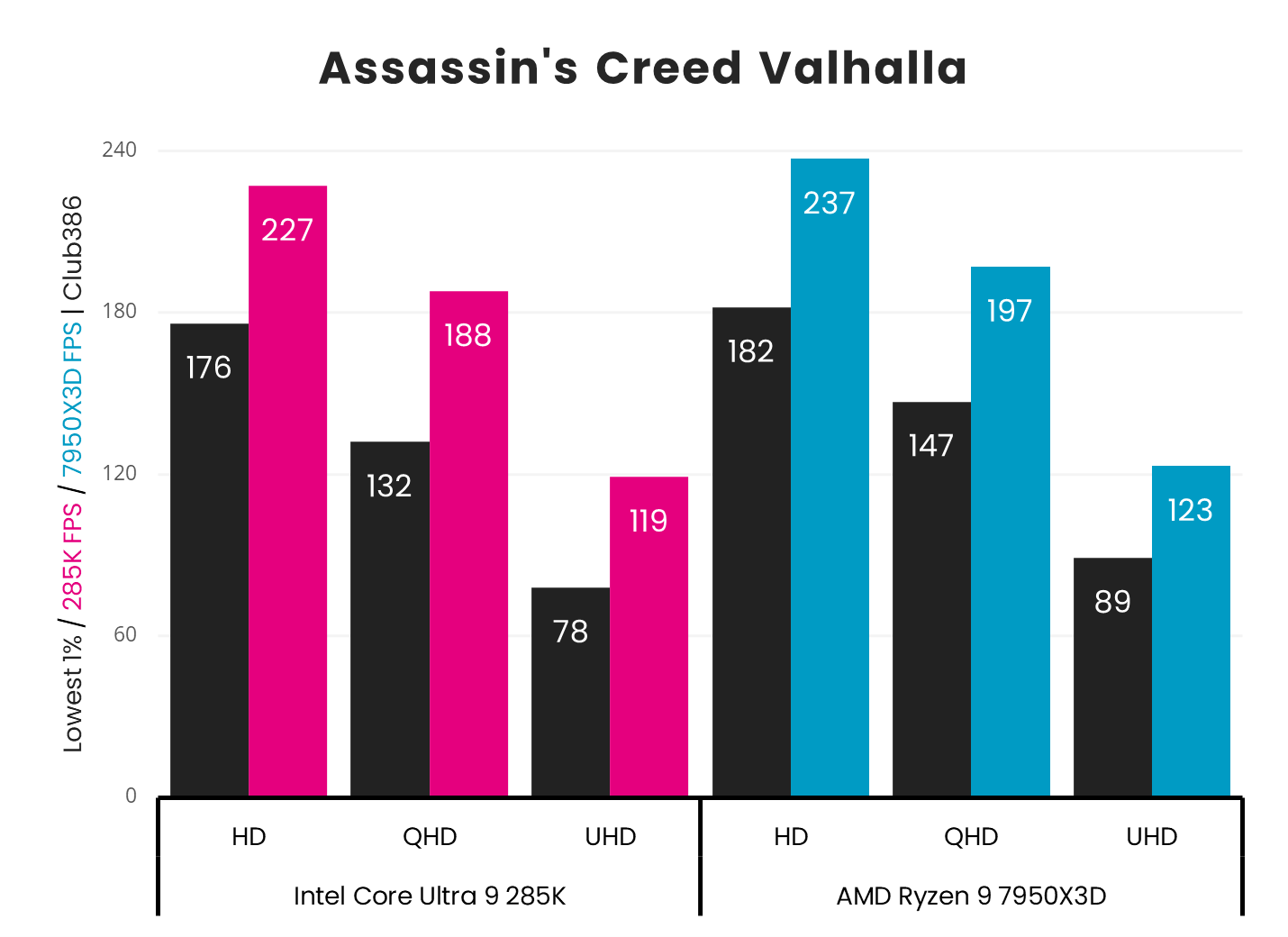
We always knew 128MB of L3 cache would set Ryzen 9 7950X3D apart from Core Ultra’s 36MB, but the difference in performance is milder than anticipated. AMD gains around 10fps more in Assassin’s Creed Valhalla at HD and QHD resolutions, with UHD falling into parity.
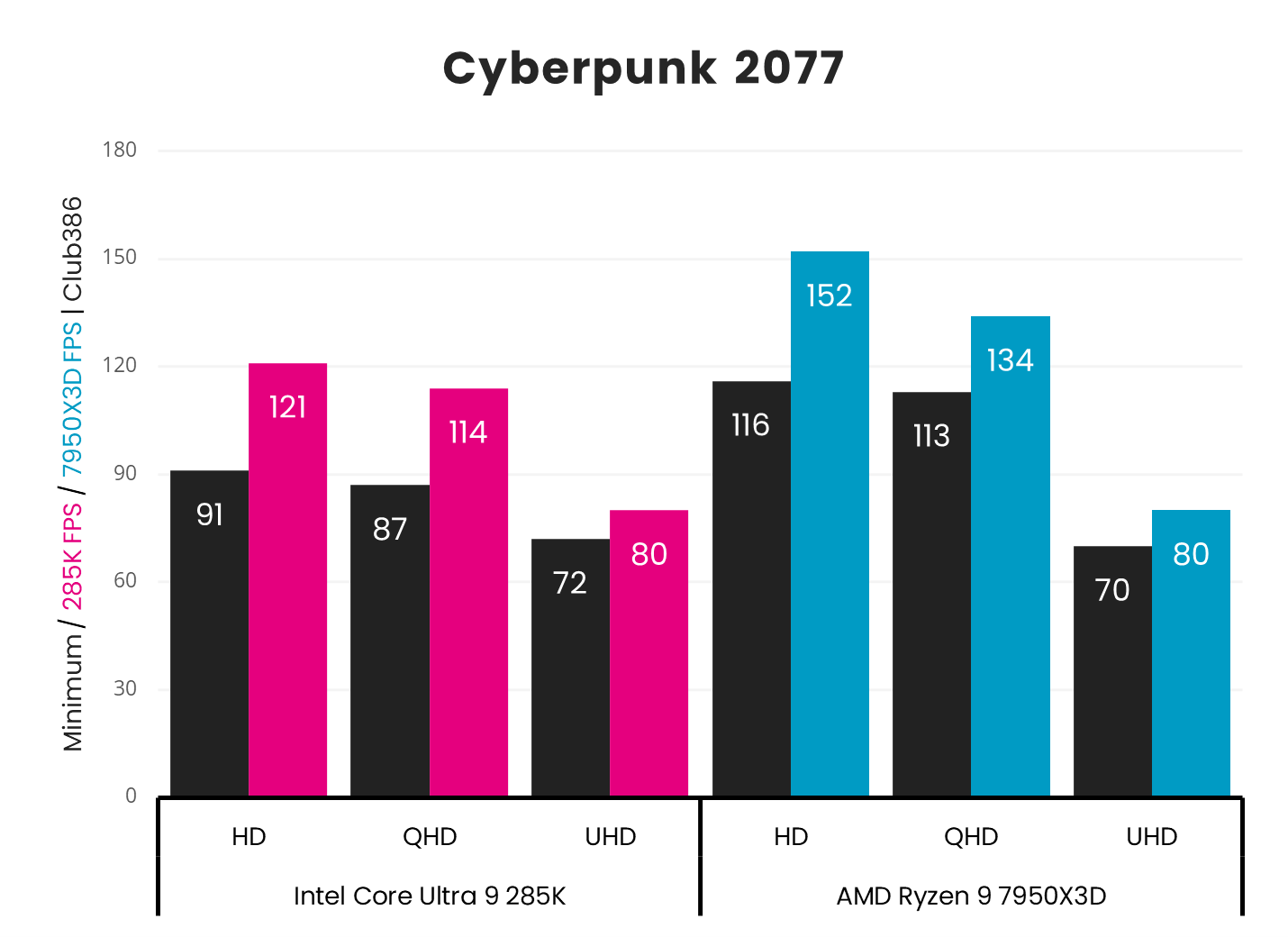
Cyberpunk 2077 usually plays favourites with AMD, and there’s no exception here. As the 31fps difference illustrates, these chips operate in a different ballpark at HD and QHD. Once again, 4K resolutions perform identically.
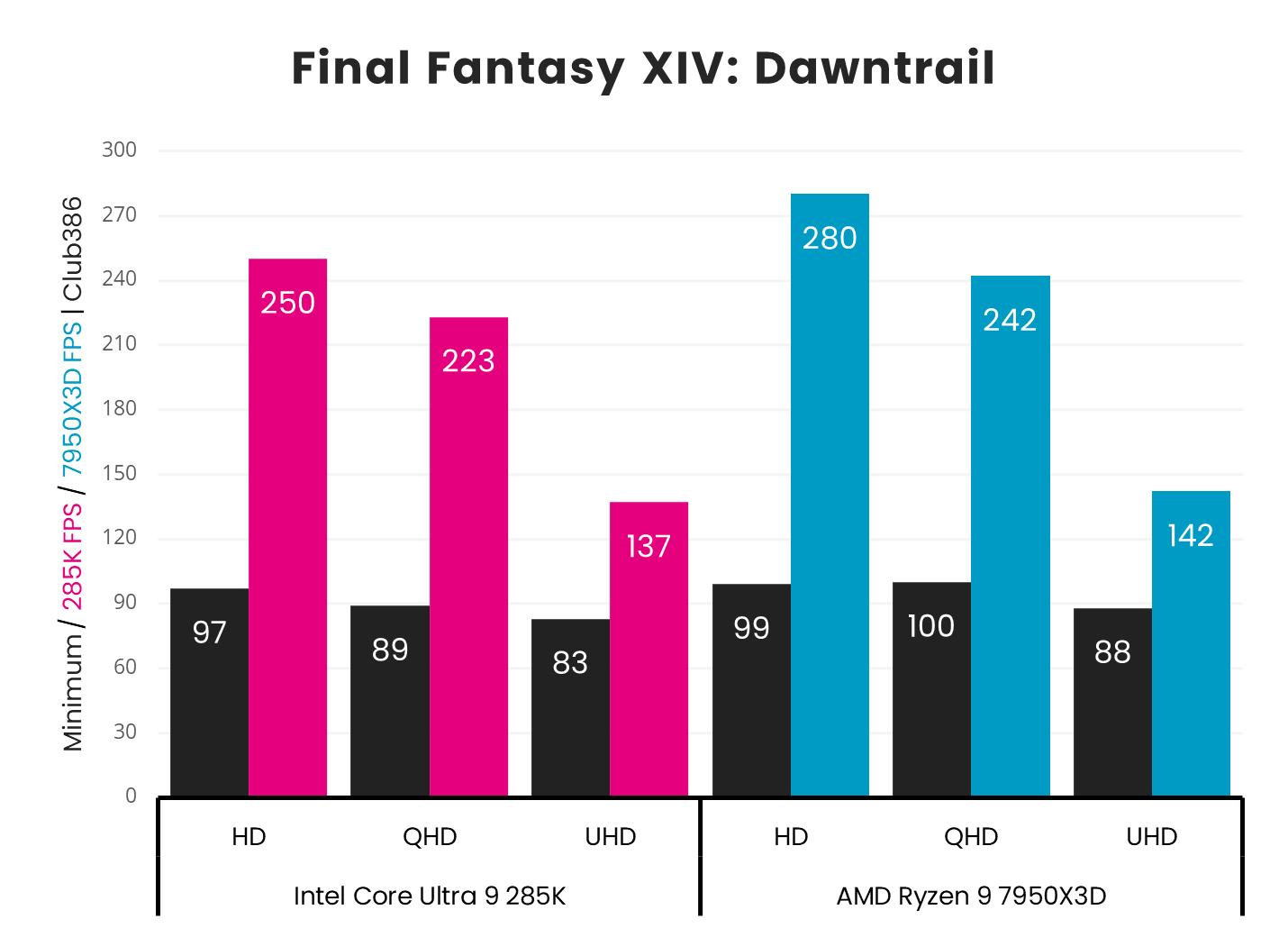
Final Fantasy XIV: Dawntrail is another game that leans more towards Team Red, offering 30fps more at HD and 19fps more at QHD. This dominance tapers off at UHD, but still affords 7950X3D an extra 5fps.
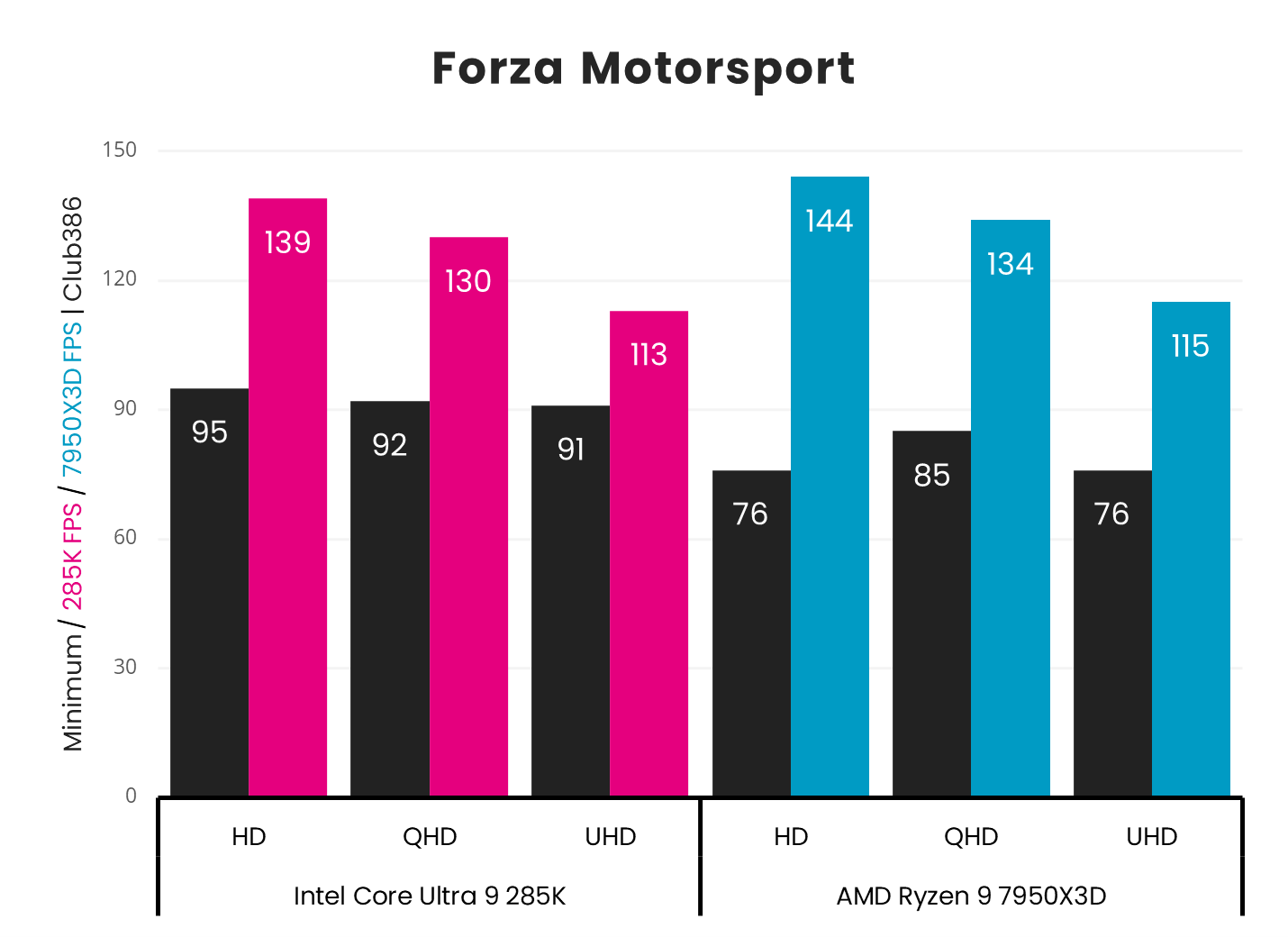
In a closer match-up, there’s no more than 5fps between each CPU in Forza Motorsport at all resolutions. You can’t go wrong no matter which way you go.
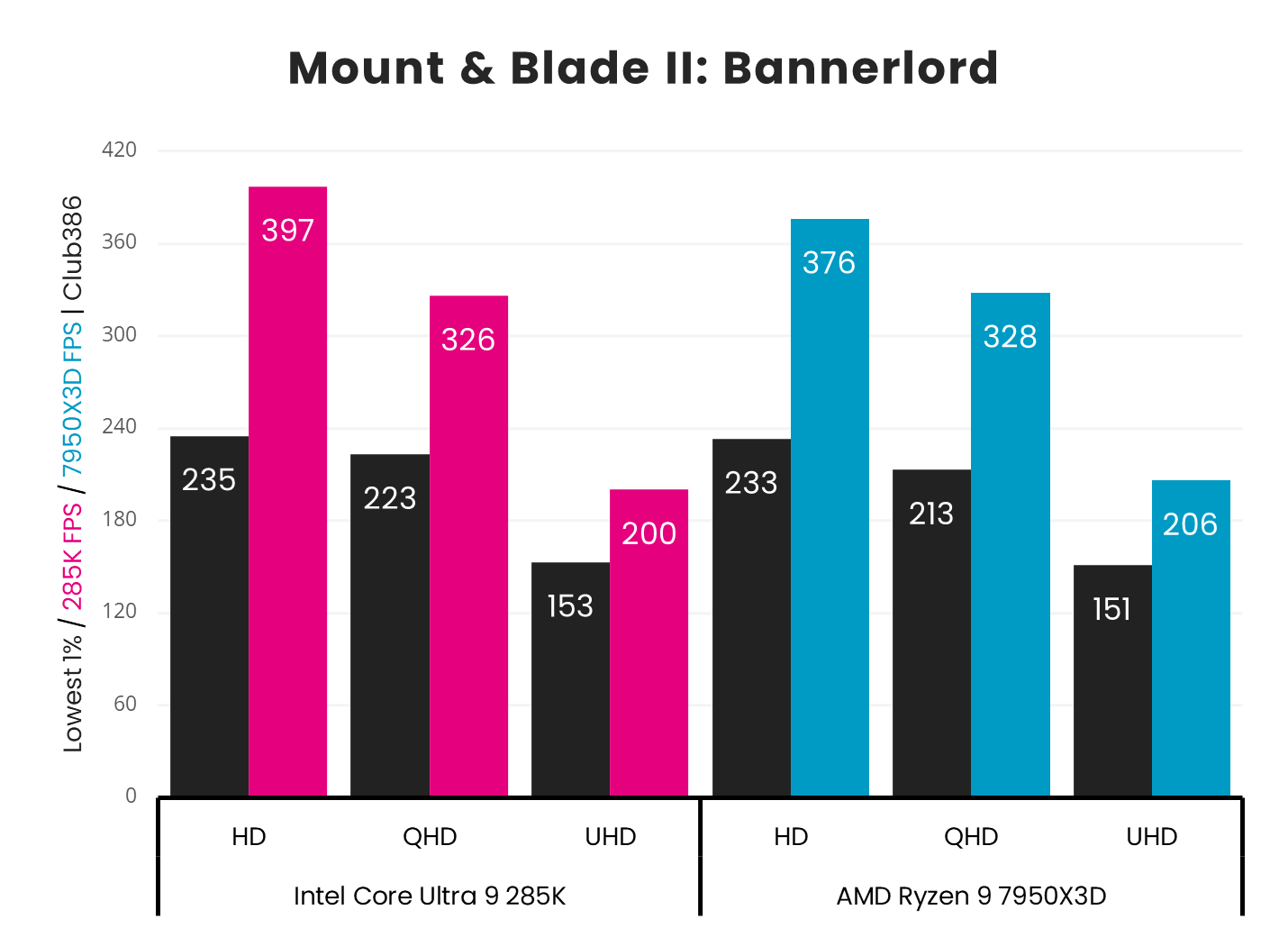
Real-time strategy (RTS) tends to work a little differently from other games, placing more focus on the CPU than other GPU-bound titles. With that in mind, Mount & Blade II: Bannerlord provides Core Ultra 9 285K with its first gaming win as Arrow Lake storms ahead with 21fps more at HD. However, the victory is fleeting as the two chips are on par at other resolutions.
Efficiency
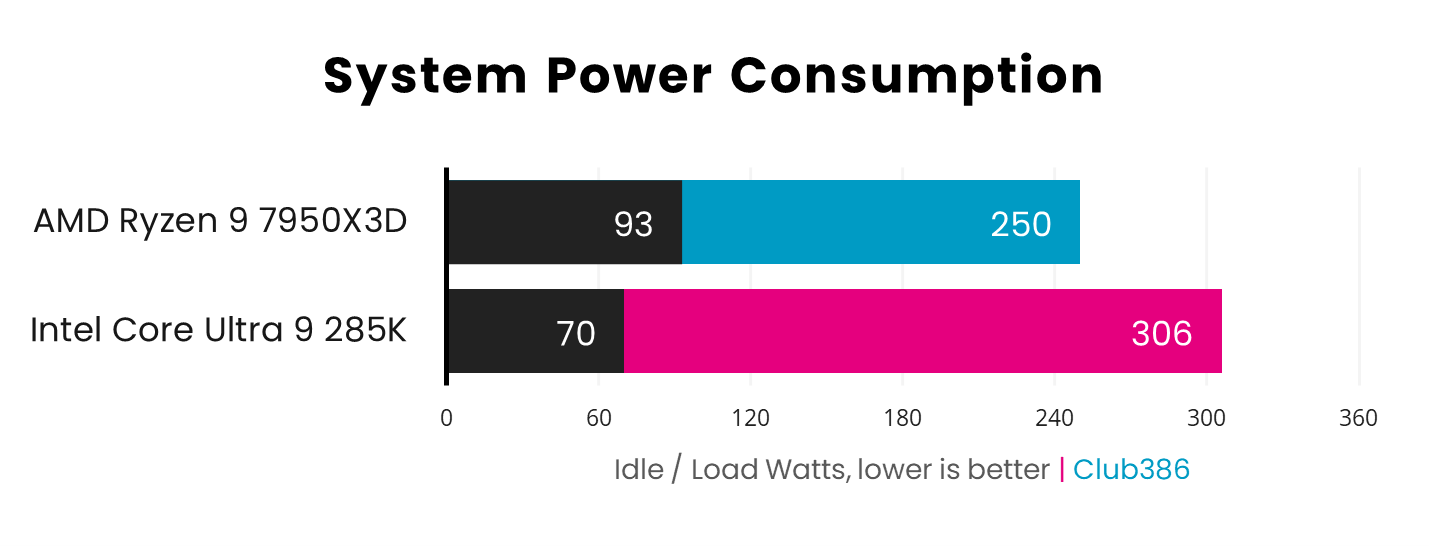
Core Ultra 9 285K is already a fantastically slim processor when it comes to power profile, sporting a conservative 306W draw under load. That said, Ryzen 9 7950X3D entirely outshines it, with its 250W being 18% more efficient. This isn’t surprising when AMD’s default TDP undercuts Intel’s by 5W.
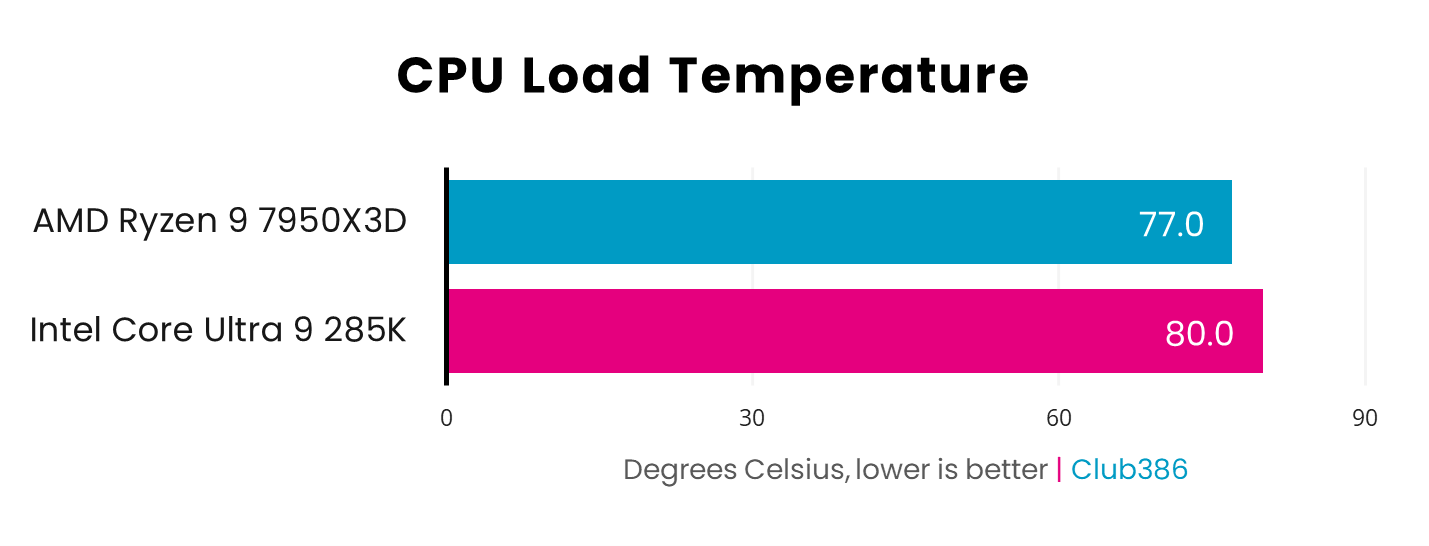
What’s 3°C between rivals? Generally, not much at all, as both stave off the threat of thermal throttling with relative ease. Still, Intel’s higher operating power and relative performance gains outside of gaming make 80°C slightly more impressive than AMD’s 77°C.
Value
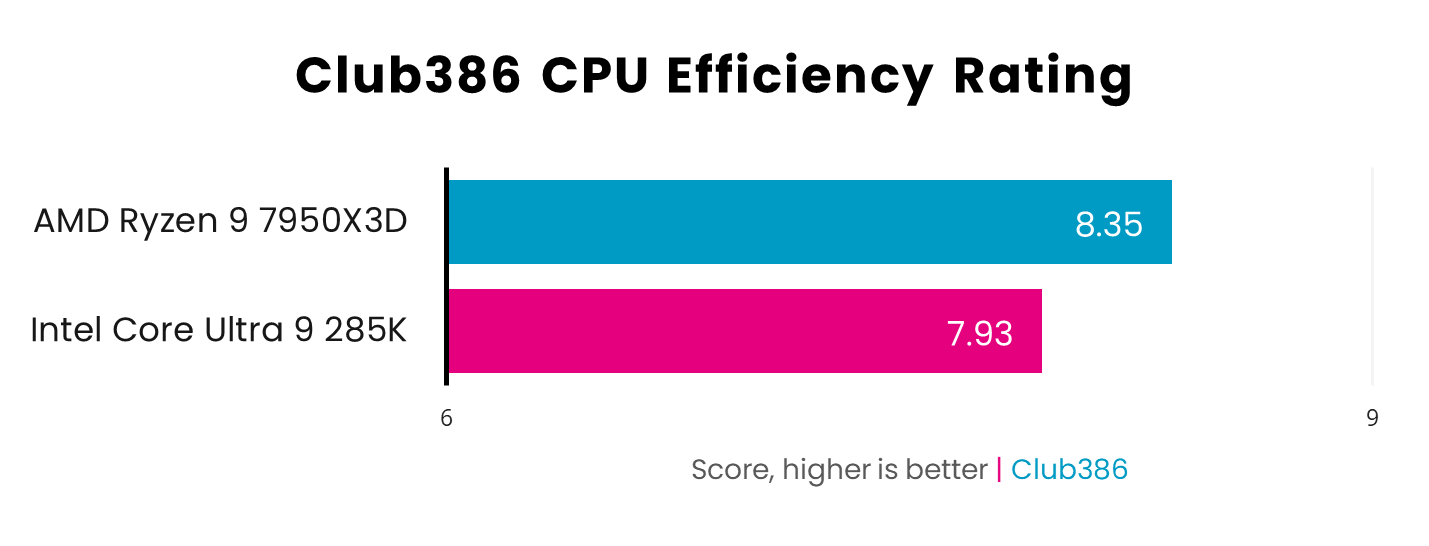
Getting Club386’s CPU Efficiency Rating is as easy as dividing a processor’s Cinebench 2024 multi-core score by system power draw under load. AMD takes the crown by 5%, but this shouldn’t sour Intel’s notable effort to keep its chips on a diet. After all, these are the gold and silver medals from every CPU we’ve put to the test.
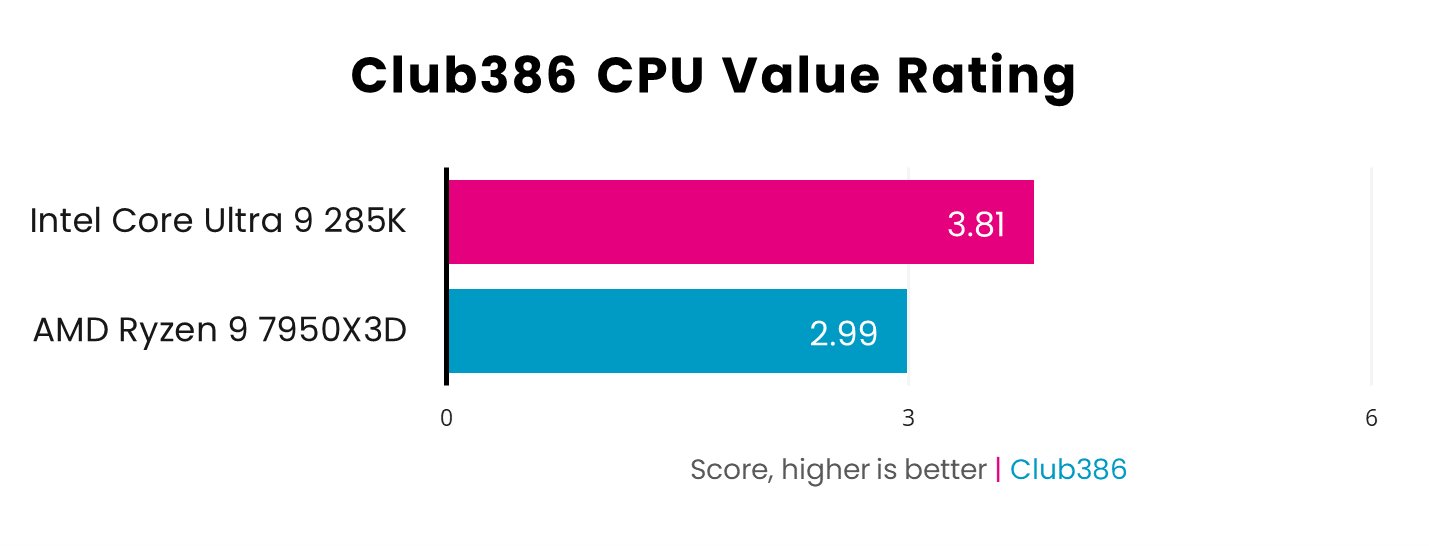
Swapping power draw for launch price in the same equation, Intel turns the tides with a 27% better Club386 CPU Value Rating. This is largely because of AMD’s eye-wateringly expensive $699 launch price.
Fast forward a year and a half after release and discounts bring 7950X3D down to $598, boosting its Value Rating to 3.49. It’s still not enough to win, but it gives its rival less than 10% headroom.
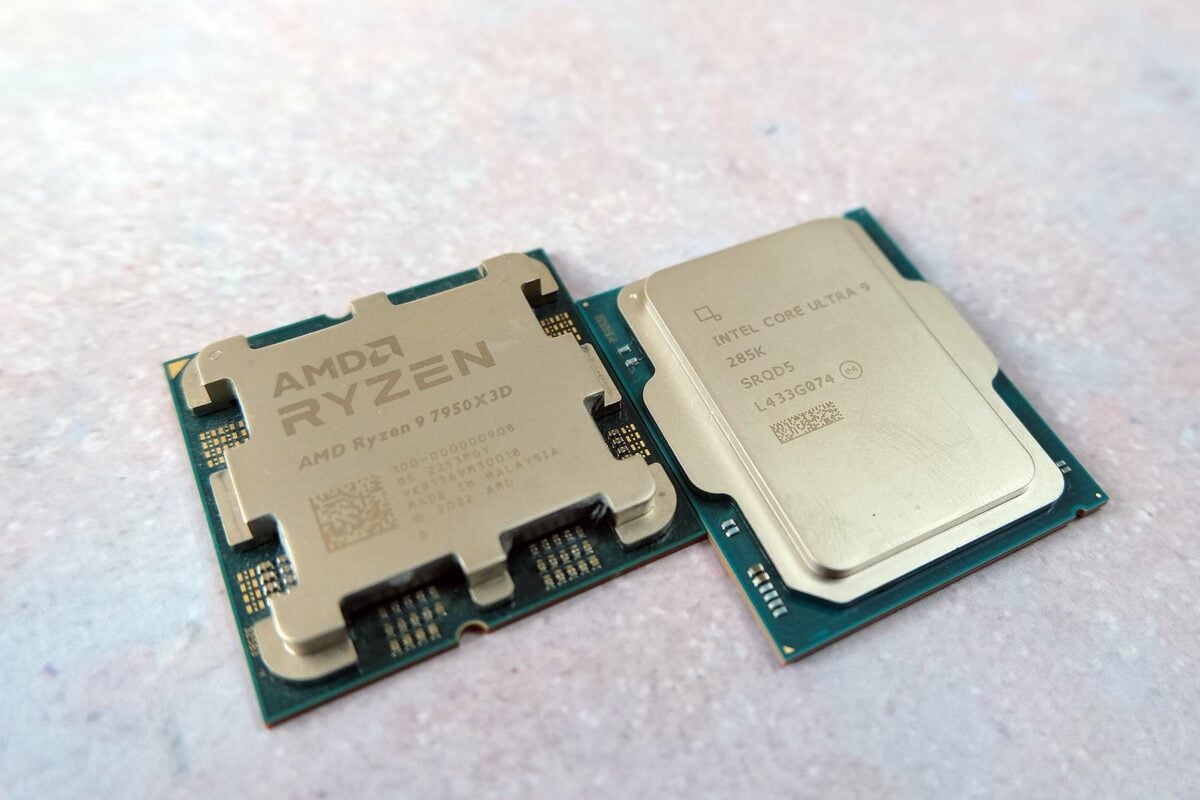
Conclusion
Arrow Lake walks a clear path designed for productivity. It handles memory supremely well and uses its extra efficient cores to strongarm the best scores in Cinebench and Geekbench, giving it superior raw CPU performance of the two. Of course, Intel Core Ultra 9 285K vs. AMD Ryzen 9 9950X paints a slightly different picture, but it’s the clear victor for most standard and AI workloads here.
On the other hand, Ryzen 9 7950X3D largely dominates in gaming thanks to an L3 cache that’s 3.5 times bigger. It doesn’t tend to affect 4K resolutions but gives AMD a leg up at HD and QHD. You’d be forgiven for forgetting this is a previous-generation Zen 4 chip we’re talking about, as it doesn’t buckle under the pressure of a current-gen fight, but the price similarly hasn’t come down enough for me to recommend it. In fact, at $598, it’s pricier than Intel’s latest.
Costs will undoubtedly change when Ryzen 9 9800X3D rolls around the corner in a few weeks, either becoming your new gaming champ, dropping the price of Ryzen 7000X3D, or preferably both. Regardless, it’s worth holding off just a little longer to get the full picture before sinking your hard-earned cash into an upgrade.
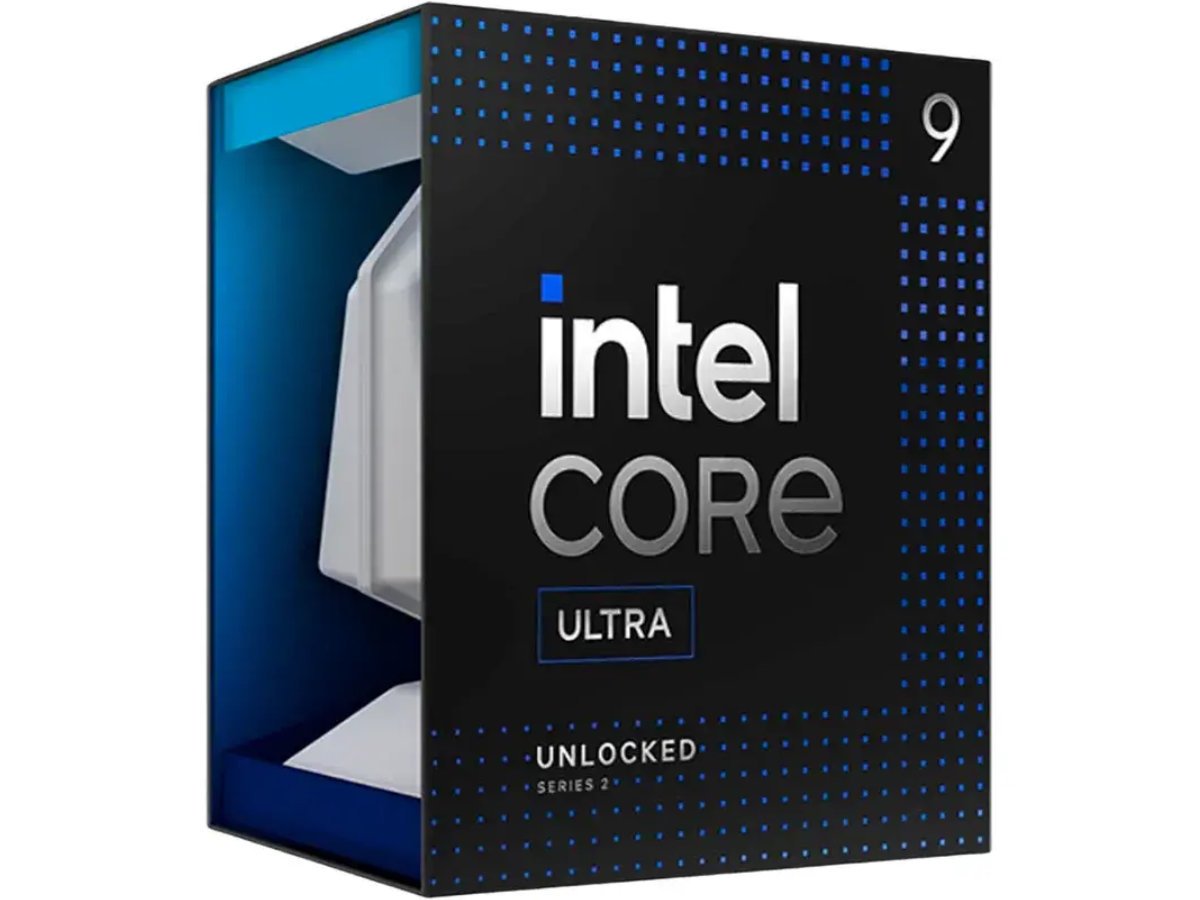
Intel Core Ultra 9 285K
Borrowing its multi-tile design from the lauded Lunar Lake architecture, Arrow Lake focuses more on efficiency while minimising sacrificed performance. Read our review.
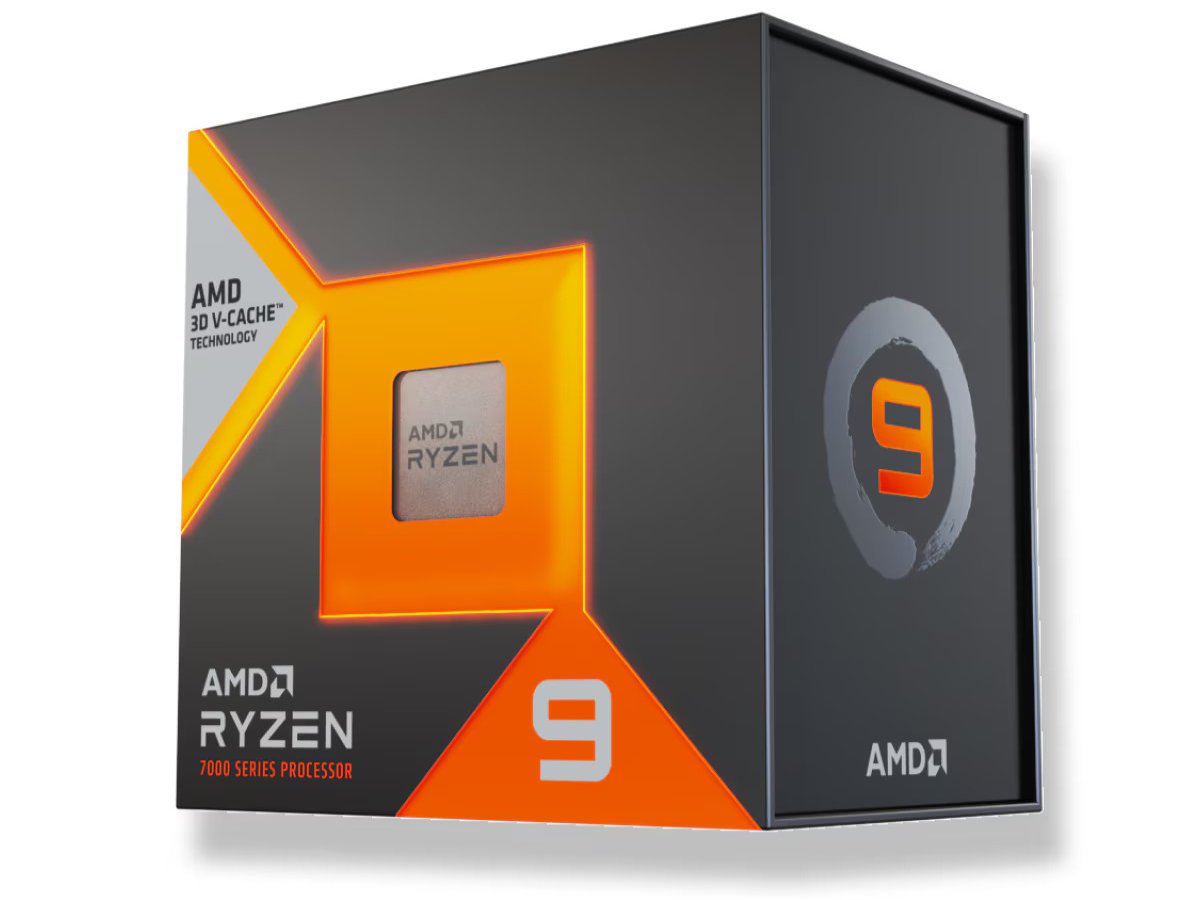
AMD Ryzen 9 7950X3D
Leveraging coveted X3D technology to bolster cache, there are few processors out there that handle games quite so well, including Zen 5. Read our review.
